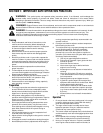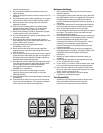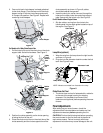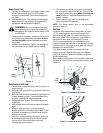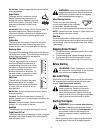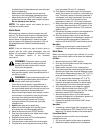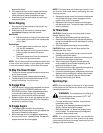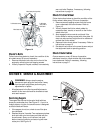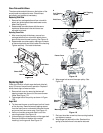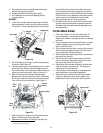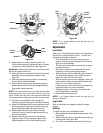
11
against the starter.
3. If the engine still fails to start, repeat the first two
steps. If continued attempts do not free starter,
follow the electric starter procedures to start.
4. Avoid freezing of the recoil starter by referring to
instructions below.
Before Stopping
1. Run engine for a few minutes to help dry off any
moisture on engine.
2. Avoid freezing of the starter by following these
steps before stopping the snow thrower:
Recoil Starter
a. With the engine running, pull the starter rope
with a rapid, continuous full arm stroke three
or four times.
Electric Starter
a. Connect power cord to switch box, then to
120 Volt AC receptacle.
b. While the engine is running, push the starter
button and spin the starter for several
seconds.
c. Disconnect power cord from the receptacle
first, then from the snow thrower.
NOTE: The unusual sound from pulling the starter rope
in case of the recoil starter, or from spinning the starter
in case of the electric starter, will not harm the engine.
To Stop The Snow Thrower
1. To stop the wheels, release the traction drive lever
on the snow thrower.
2. To stop throwing snow, release auger drive lever.
3. To stop engine, push throttle control lever to OFF
and pull out the key. Do not turn key.
To Engage Drive
1. With the engine running near top speed, move shift
lever to one of six FORWARD positions or two
REVERSE positions. Select a speed appropriate
for the snow conditions that exist. Use slower
speeds until you are familiar with the process.
2. Squeeze traction drive clutch grip against the right
handle and the snow thrower will move. Release it
and the drive motion will stop.
To Engage Augers
1. To engage augers and start snow throwing,
squeeze the left hand auger clutch grip against the
left handle. Release to stop augers.
2. While the auger control is engaged, squeeze the
drive control to move, release to stop. Do not shift
speeds while the drive is engaged.
NOTE: This same lever also locks auger control so you
can turn the chute crank without interrupting the snow
throwing process.
3. Release the auger control; the interlock mechanism
should keep the auger control engaged until the
traction drive control is released.
4. Release the drive control to stop both the augers
and the wheel drive. To stop the auger, both levers
must be released.
To Throw Snow
CAUTION: Check the area to be cleared for foreign
objects. Remove, if any.
1. Start the engine following starting instructions.
2. Rotate the discharge chute to the desired position,
(away from bystanders and/or buildings) by moving
the chute control.
3. Select the speed according to snow condition.
CAUTION: Never move the shift lever without first
releasing the drive clutch.
4. Engage the auger control and drive control levers
following instructions above.
5. The interlock feature will allow you to remove your
left hand from the auger control lever.
6. When clearing the first pass through the snow,
control speed of snow thrower according to the
depth and condition of snow.
7. To turn the unit left or right, squeeze the respective
wheel steering control. See Figure 12.
8. On each succeeding pass, readjust the chute to the
desired position and slightly overlap previous path.
9. After the area is cleared, stop the snow thrower
following instructions given below.
Operating Tips
NOTE: Allow the engine to warm up for a few minutes
as the engine will not develop full power until it reaches
operating temperature.
• For most efficient snow removal, remove snow
immediately after it falls.
• Discharge snow downwind whenever possible.
Slightly overlap each previous swath.
• Set the skid shoes 1/4" below the scraper bar for
normal usage. The skid shoes may be adjusted
upward for hard-packed snow.
NOTE: It is not recommended that you operate this
snow thrower on gravel as loose gravel can be easily
picked up and thrown by the auger causing an injury or
damage to the snow thrower.
WARNING: The temperature of muffler and
surrounding areas may exceed (150
o
F (65
o
C). Avoid these areas.



